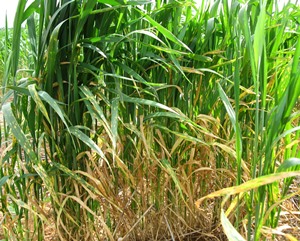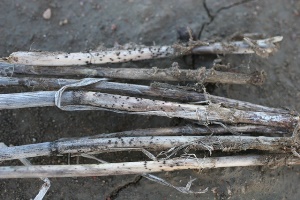Yellow leaf spot of wheat
Yellow leaf spot, also known as tan spot, has become a widespread and important disease of wheat in Victoria. It has been supported by stubble retention, intense wheat production in the rotation and widespread cultivation of susceptible wheat varieties like Yitpi.
What to look for
Yellow leaf spot is most often observed in seedlings, but when conditions are suitable it can progress up the plant where it causes significant yield loss.

The first symptoms appear on leaves as small tan oval spots or lesions surrounded by a yellow halo (Figure 1).
Individual lesions may vary in shape and size, often expanding and joining together with other lesions. The tips of severely affected leaves soon yellow and die.

Accurate diseases identification is important as symptoms of yellow leaf spot can be confused with other disorders like aluminium toxicity or herbicide damage.
Economic importance
In isolated cases, in particular when susceptible wheat varieties are sown into wheat stubble, heavy infestations of yellow leaf spot can caused yield loss when the flag and upper leaves become infected.
In most years, yellow leaf spot only infects the lower leaves and is generally regarded as causing limited yield loss.
However, research in 2012 and 2013 found infection of the lower leaves by the yellow leaf spot fungus reduced the yield of resistant varieties (MR and MRMS) by approximately 4 per cent and susceptible varieties (S and SVS) by approximately 15 percent.
Disease cycle
Yellow leaf spot (tan spot) caused by the fungus Pyrenophora tritici-repentis, is predominantly a stubble-borne disease.

This fungus survives between crops on cereal stubbles as mycelium in stubble and can survive on stubble for up to 2 years, if seasons are very dry.
In the late summer/early autumn the fungus develops small black fruiting bodies on the stubble. The fruiting bodies, or pseudothecia, contain large numbers of sexual spores which are forcibly ejected during cool (15°C) humid conditions. Spores land on nearby wheat plants and will infect leaves if they remain wet for more than 6 hours.
Often the early infection of seedlings does not progress to adult plants. However, when conditions are wet during the season, asexual spores or conidia are produced in leaf lesions. This secondary spore is dispersed by the wind, and can result in rapid disease development higher up the plant and in neighbouring wheat crops.
It is this secondary spread that causes high yield loss.
Management
Yellow leaf spot is most severe where successive wheat crops are grown on retained stubble. It is essential not sow wheat into infected stubble.
Rotating wheat with barley, oats or a non cereal crop will reduce the impact of this disease.
Foliar fungicides are registered to control yellow leaf spot but they may not be economical. Fungicides are most likely to give an economic return when:
- yield potential is above 3.0 t/ha
- a susceptible variety is being grown
- 5 per cent of the Flag (-2) leaf and Flag (-3) leaf are affected.
Under these conditions, a fungicide application should be made prior to or just after rain, between flag leaf emergence and late booting. This will prevent the disease from moving up onto the flag leaf.
The pressure from yellow leaf spot will be greatly reduced if susceptible (S) and very susceptible varieties (VS) are replaced by varieties moderately susceptible (MS) or better to yellow leaf spot.
Reducing the number of susceptible crops grown in a district will reduce inoculum load from season to season. Complete resistance is not needed to achieve sustainable control of this disease. See the Victorian Cereal Disease Guide for resistance ratings.
Seed and fertiliser treatments are not effective against this disease.
Further information
Contact
Dr Grant Hollaway
Dr Mark McLean
Cereal Pathologists – Horsham
03 5450 8301
Field Crops Pathology
Grains Innovation Park
110 Natimuk Rd
Horsham 3400
03 5450 8301
Or call the Customer Service Centre, 136 186
Acknowledgments
Grant Hollaway, Frank Henry. Support by the Grains Research and Development Corporation is gratefully acknowledged.